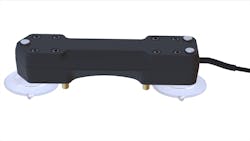Blueline Sensors released its most advanced tactical contact microphone to date. The WASP3 Tactical Contact Microphone, designed with tactical teams, crisis negotiators and technical investigators in mind, detects even whisper-level sounds through doors, walls, windows and floors, delivering incident intelligence from inside of denied-access scenes. Unlike under-door microphones, which require a gap between the floor and the bottom of a door, a contact microphone detects sounds through even completely sealed doors, solid walls, or other building materials, including gypsum panels, wood, steel, and even masonry, without needing an air path to the space on the other side or the risk of being seen from inside. This works because airborne sound interacts with building partitions and is converted into microscopic particle motion within solid materials. When instantly attached to a partition using double-sided tape pads, its built-in magnets or replaceable suction cups, the WASP3 mic detects the tiny changes on the surface of the partition and converts them into amplified audio signals that can be monitored in real time or recorded. Used properly, a contact mic can provide valuable intelligence about critical incident scene activities, for example, unseen suspect movements, or quietly spoken planning between occupants, and does not rely on access to the scene or a suspect willing to accept a throw phone.
The 3rd generation WASP3 Tactical Contact Microphone is not an accelerometer or a vibration sensor that requires large motions of heavy walls or doors perpendicular to their surfaces. Instead the WASP3 converts imperceptible mechanical motion of the surface to which it is attached directly into electrical energy, without strong dependence on the direction of arrival of the detected motion. In contrast, accelerometers respond mostly to vibrations in the direction of a single axis of sensitivity. Conversely, and to its advantage, the WASP3 gathers the energy of sound-induced surface motions which arrive from all angles, resulting in an extremely high sensitivity.
Despite their versatility contact microphones are not perfectly suited to all situations. Like all tools, they work well for some purposes but not as well for others. If an air-path into the scene is present and the threat level allows for insertion of a microphone near the source of sound, then using a standard air-microphone may provide the clearest audio. But when there is no air-path for sound (such as holes, cracks, gaps under a door, etc.) then a contact microphone may be the only way to know what your tactical team is heading into.
